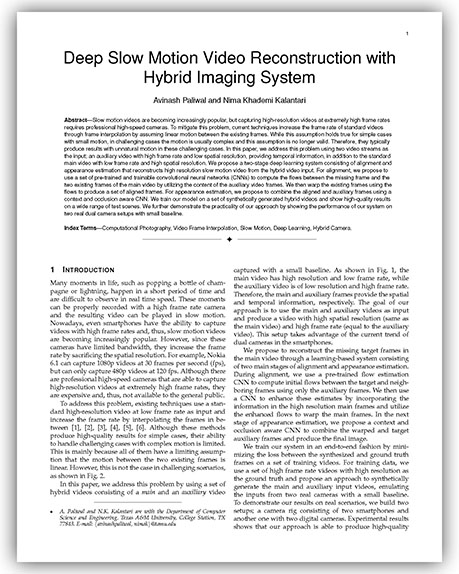Deep Slow Motion Video Reconstruction with
Hybrid Imaging System
PAMI (ICCP 2020)
-
Avinash Paliwal
Texas A&M University -
Nima Khademi Kalantari
Texas A&M University
Abstract

Slow motion videos are becoming increasingly popular, but capturing high-resolution videos at extremely high frame rates requires professional high-speed cameras. To mitigate this problem, current techniques increase the frame rate of standard videos through frame interpolation by assuming linear object motion which is not valid in challenging cases. In this paper, we address this problem using two video streams as input; an auxiliary video with high frame rate and low spatial resolution, providing temporal information, in addition to the standard main video with low frame rate and high spatial resolution. We propose a two-stage deep learning system consisting of alignment and appearance estimation that reconstructs high resolution slow motion video from the hybrid video input. For alignment, we propose to compute flows between the missing frame and two existing frames of the main video by utilizing the content of the auxiliary video frames. For appearance estimation, we propose to combine the warped and auxiliary frames using a context and occlusion aware network. We train our model on synthetically generated hybrid videos and show high-quality results on a variety of test scenes. To demonstrate practicality, we show the performance of our system on two real dual camera setups with small baseline.
Technical Video
BibTeX
@article{paliwal2020slowmotion, title={Deep Slow Motion Video Reconstruction with Hybrid Imaging System}, author={A. {Paliwal} and N. {Khademi Kalantari}}, journal={IEEE Transactions on Pattern Analysis and Machine Intelligence}, year={2020}, volume={42}, number={7}, pages={1557-1569}}Acknowledgements
We thank the ICCP reviewers for their comments and suggestions. We also thank Luke M. Schmidt for providing insight into designing the digital camera rig, and Deepankar Chanda for help with collection of videos. The JUGGLER and HORSE scenes are from YouTube channels Curtis Lahr and Sony India, respectively. This work was in part supported by TAMU T3 grant - 246451. The website template was borrowed from Michaël Gharbi and Ben Mildenhall.


